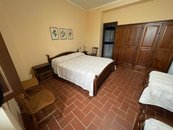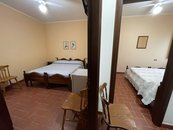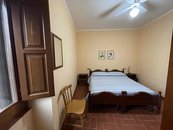Agriturismo Torre Vecchia di Marafi
Via Marafi -137, 82030 Faicchio (Benevento) Code
Profile
In brief
- Type: Bedroom (2), Flat (1),
- Guests: 12
- Map: Plains
- Type of accommodation: Room only, Bed & Breakfast
The agriturismo
Covering more than 80 hectares and nestled in an enchanting lush setting at the confluence of the Titerno and Volturno rivers, 30 km from Benevento, is the Torre vecchia di Marafi farmhouse.
In this evocative atmosphere of bygone times rich in the history and tradition of Sannio and Campania, you can indulge in long wooded walks and fully enjoy the spectacular naturalistic landscape or relax by the pool.
In addition, the size of the rooms and spaces enjoyed by the structure offers the possibility of holding ceremonies and private parties in the internal rooms as well as in the spacious internal courtyard equipped with an ancient well.
The accommodation
The mighty structure, which incorporates a pre-existing tower, consists of a large courtyard with a central well along which open several rooms used for dining services and dining rooms for 90 seats at the table, as well as a meeting room dedicated to guests; on the upper floor, on the other hand, there are three comfortable lodgings with bathrooms for a total of 12 beds.
The Mulberry has one double bed and two single beds.
The Platano has two bedrooms (two doubles).
The Rubinia has one bedroom with a double bed and one room with a kitchenette with a double sofa bed.
Castrum Marafi, dates back to very ancient times, as reported by historian Meomartini "...probably marked the border between the Samnites Caudini and the Pentri."
The name Marafi of Lombard origin suggests a defensive purpose from the incursions of the Greeks and Saracens who until the 10th-11th centuries raged throughout the territory. More certain news of the group of Corti in the ager of Faicchio dates back to 1187 on the occasion of the pact of union made on the occasion of the Crusade to the Holy Land called by Gregory VIII under William the Good. Castrum Marafi appears to still exist in the 16th century, listed as a Baronial fief in an instrumento di convenzione between Baron Paolella of Puglianello and D'Autellis of Marafi, drawn up by Notar Bettinelli of Naples on November 12, 1551. Candida attests that at the end of the 16th century the fief was acquired by the Royal Chamber and resold in 1579 to Giovanni Monsorio, Butler of the Court.
It was running the year 1612 when the fief became the property of Gabriele Martino, whose dynasty maintained it, along with the title of Duke, until the abolition of feudal privileges.
The ancient court today is reborn in the De Ciampis family's agriturismo, the vast estate includes remains of ancient farmhouses and attached to the Tower is the medieval church that until 1407 formed Rectory with the title of San Andrea de Cortesano, a destination for pilgrims, nobles, prelates and knights. The church can be used for ceremonies and events.
The main activity of the farm israising sheep of the prized Laticauda breed, typical of these areas. The animals feed on fresh fodder supplemented by cereals and dry fodder produced on the farm. The meat of these sheep, aromatic and delicate, due to the very low caprylic and capronic acid content, has a lower cholesterol level than that of other sheep breeds. At Torre Vecchia, respect for tradition is also observed in the preparation of ancient Sannio recipes, offered today by the refined kitchen, with typical delicacies such as house antipasti, handmade pasta, grilled meats, boiled sheep with herbs and traditional Sanniti sweets.
Activities and surrounding
An itinerary to discover Sannio must start from the provincial capital, Benevento, which still expresses much of the past culture of the Samnite people. The visit starts from Piazza Castello in which it is also possible to admire the World War I war memorial. The city's strength lies in the fact that it has managed to integrate urban modernization with a historic center of the highest cultural value. A stop at the Rocca dei Rettori is a must to admire a splendid view. The symbol of Benevento is theArch of Trajan, a must-see monument.
From Benevento we move on to Pietrelcina, a small medieval village perched on a rocky ridge, surrounded by dense vegetation based on centuries-old olive trees. The atmosphere here is almost surreal, as this is the town that gave birth to Padre Pio; indeed, it almost seems as if everything here exudes spirituality. A visit to the saint's birthplace is a must, as is his home as a priest. Also of artistic, as well as spiritual, interest is the church of St. Anne. The quaint old town, called Rione Castello, with its distinctive houses made of stone leaning against each other, and the town's contrada, Piana Romana, tell of both the friar's youth and the traditions of an essentially rural center, which have not been lost at all.
Just 5 minutes from Torre Vecchia di Marafi is FAICCHIO, a delightful village at the foot of Mount Maple in the province of Benevento. The historical origin of the village dates back to very ancient times, as evidenced by the numerous archaeological finds that have been unearthed, which date it to the Neolithic Era.
Faicchio is clustered around the 12th-century Ducal Castle, and in addition to this there are other sacred sites and a remarkable historical heritage, including:
- the "Fabio Massimo" bridge dating back to the 3rd century B.C. About five feet wide, the bridge rests on polygonal pillars. Tradition has it that Hannibal passed over this bridge with his troops;
- the Roman or Aqueduct of Fabius Maximus from the 3rd century B.C., in the hamlet of Fontanavecchia, is the only example of an aqueduct of the period still in working order;
- the Grotto of St. Michael, home of the hermits, with 12th-century frescoes, is a very impressive place to visit and a pilgrimage destination;
- the Convent of San Pasquale, in which to admire the 18th-century side frescoes, the fully decorated ceiling, and the 12 side ceramics from the 18th-century school of Cerreto San Lorenzello;
SAN LORENZELLO and CERRETO SANNITA are 10 minutes away; the former, from time immemorial, boasts pottery making, with decorations ranging from religious or naturalistic inspired themes to those with landscape or allegorical subjects.
In the 18th century, the golden age of ceramic production, entire families devoted themselves to this art in the many workshops in the urban center and suburbs.Laurentine master potters were so famous and appreciated that some were called to work in the most prestigious factories of the time.
Ten minutes away is TELESE TERME, the protagonist in the past of epic scenes that were the Samnite wars, the Punic wars and the social wars. The abolition of feudality in 1806 marked the beginning of the civil, social and economic revival of the entire territory. The characteristic feature of the town is the thermal baths that were created after the disastrous earthquake of 1300, which repaid Telese with a rich heritage of sulfurous waters.
The various villages perched on the various hills in the area, during the summer months are full of festivals of typical local products. It is worth mentioning that this is the land of production of one of Campania's most interesting wines: Solopaca.
A small town in the Benevento Apennines, San Marco dei Cavoti, is most famous for the production of a particular and delicious torroncino, made from chocolate. Benevento stands out for its Strega liqueur, made by distilling saffron.
CERRETO SANNITA, entirely rebuilt after the disastrous earthquake of 1688, is characterized by its original urban layout and is known for its traditional production of artistic ceramics, produced there since the 13th century. In the rooms of the "cantinone" of the cloister of the monumental Palazzo S. Antonio, the "Museo Civico della Ceramica Cerretese" was established in 1991, a collection of more than 400 pieces dating back to the 18th century.
Services
Available services
- Theme Parks and Water Parks
- Nature Reserves
- Museums and galleries
- Artistic and historical sites
- Spa
- Hiking
- Bird watching
- Hunting
- Fishing
- Horse riding
- Tennis
- Shopping
Restaurant & Events
Restaurant services
- Children's menu
- Local cuisine
- Menu with farm products
Open to
Everyone
Table reservation
Reservation needed
Seats
Up to 90
Menu
Set menu
Average price
35€
Specialties you may find
- Pasta fatta in casa
- Grigliate
- Torte rustiche al formaggio
- Timballi
- Dolci tradizionali
Wedding in Italy, Parties & Celebrations
Available rooms/spaces
- Reception room
- Garden
- Parking
- Bridal suite
Services
- On-site restaurant
- Reception
Guests
from
10
to
90 Guests
Corporate Events
Activities
- Team building
- Gala dinners
Services
- Wi-fi
- Parking
Guests
from
10
to
90
N° meeting rooms
1
Largest meeting room
90 seats
Tastings
Products
- Wine tasting
- Oil tasting
- Cheeses tasting
- Truffle tasting
- Hot samples
- Cold samples
Provenance
- Own production
- Selection of local products
Booking required
Yes
Participants
50
(Translated with Google Translate) Read more
(Translated with Google Translate) Read more
Map
Faicchio (Benevento) Print directions from host
The telephone number is:
By calling the phone number I declare that I am of age and accept the terms and conditions of use and privacy policy.


